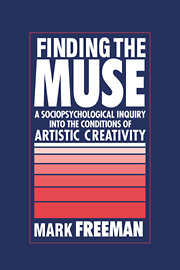Book contents
- Frontmatter
- Contents
- Acknowledgments
- Chapter 1 SOCIAL REALITY AND THE SPACE OF CREATIVITY
- Chapter 2 TO BE AN ARTIST
- Chapter 3 IN THE COMPANY OF OTHERS
- Chapter 4 CREATIVITY AND THE MARKET
- Chapter 5 THE DREAM OF ARTISTIC FREEDOM
- Chapter 6 THE CONDITIONS OF CREATIVITY
- Appendix: The Artists Project
- References
- Index
Chapter 5 - THE DREAM OF ARTISTIC FREEDOM
Published online by Cambridge University Press: 04 December 2009
- Frontmatter
- Contents
- Acknowledgments
- Chapter 1 SOCIAL REALITY AND THE SPACE OF CREATIVITY
- Chapter 2 TO BE AN ARTIST
- Chapter 3 IN THE COMPANY OF OTHERS
- Chapter 4 CREATIVITY AND THE MARKET
- Chapter 5 THE DREAM OF ARTISTIC FREEDOM
- Chapter 6 THE CONDITIONS OF CREATIVITY
- Appendix: The Artists Project
- References
- Index
Summary
THE RHETORIC OF PLURALITY
As I acknowledged in the introductory chapter of this book, much of what the artists in the present group indicated about the inner workings of the domain of art came as something of a surprise. Partly this had to do with my own naïveté about the contemporary art scene; although I certainly had a serious interest in art prior to that time, I was hardly well schooled in its subtleties and complexities. This surprise, however, also had to do with the fact that a significant portion of the literature I had read in order to learn more about what was happening presented a picture of the situation of contemporary art that frequently ran counter to what I eventually heard from artists themselves.
Of the 1960s, for instance, Adams (1978, p. 7) has written, “Never before had there been such tolerance or such great variation both in style and in what was admissible art practice”; there was at this time, Kostelanetz (1980, p. 19) adds, “unprecedented permissiveness” in what could be considered art and in the actual creation of works of art themselves. This basic state of affairs was seen by some to extend in the 1970s as well, another writer (Robins, 1984) dubbing the era the “pluralist” era, one in which art had become nonsuccessive, nonheroic, and populist – quite the opposite, for this woman, of what modernism had been all about. As still another writer (Smagula, 1983) has framed it, gazing now in the art of the 1980s: “We face the most pluralistic, complex, and contradictory era the world has ever known” the situation of contemporary painting consisting “mainly of individuals embarked on personal journeys of artistic self-discovery and fulfillment” (p. 40).
- Type
- Chapter
- Information
- Finding the MuseA Sociopsychological Inquiry into the Conditions of Artistic Creativity, pp. 186 - 250Publisher: Cambridge University PressPrint publication year: 1994



